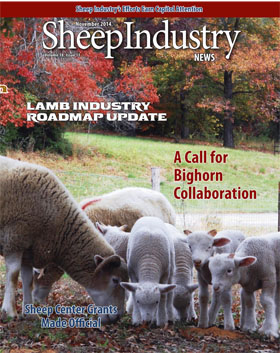To View the November 2014 Digital Issue — Click Here
Benefits of ‘New World’ Sheep Production
By Clint Krebs
I have enjoyed researching the history of our sheep industry and the organizations which have represented sheep producers for the last 150 years.
Some of the practices we use today to raise sheep haven’t changed much with time. In fact, I just attended a meeting in Denver, and yes, there are still ranches using horse teams to move sheep camps, and not everyone has given up their pack mules in exchange for a side-by-side. Hearing about how and why some of the old ways are “still the best” made me think about which of the “new world” ways have been the most beneficial to sheep producers. I will share my first thoughts, and I invite people to send in their own ideas.
There were no antibiotics 150 years ago. There were things like Sheep Dip, Blue Vitriol, Bag Balm, and mineral oil. So how did people take care of sheep with pneumonia, or treat scours? My son asked me what my grandfather used to doctor lambs with shipping fever, and the only answer I could come up with was, “feed and water, and then get a shovel.”
What about vaccines? My Grandfather never once vaccinated a sheep, but today the practice is common. We also have to think about wormers. I know there were home remedies for de-worming sheep, but I think the biggest tool, “in that battle”, was natural resistance. If the sheep didn’t have resistance, they died. I never had to run sheep through a dipping vat, but there were vats on the ranch, (they looked like a lot of work), so I am really thankful to be able to put pour-on down the back.
What about the interstate highway system? It used to take three trips of seven hours each to deliver our wool – in a 1954 Chevy two-ton truck – to Pendleton Woolen Mills. Now it is one load in three hours. We have to thank President Eisenhower for that. And, if we are going to talk about roads and interstates, we have to add pickups. Next time you get your Dodge 4-wheel drive stuck trying to feed hay in the snow, ask yourself how the sheep got fed with 2-wheel drive, or what happened in a snow storm a 150 years ago. Maybe, both the people and the sheep, were tougher back then.
We can’t forget the change from blade shearing and to hand pieces, line machines and then electricity. I was never on that end of the shearing detail. I was the one loading wool sacks, so my top vote for improvements in our industry, has to be hydraulic loaders on tractors –used today, to not only load wool and hay, but to clean and scoop pens. All of these jobs were done by hand with pitchforks. In my opinion, the best use of a pitchfork today is gaffing salmon.
Speaking of modern times
I have enjoyed my travels representing the industry – except for when I have to ride in a taxi. They make me really nervous, by accelerating and then decelerating, changing lanes to the left three times in heavy traffic, and then coming back three times to the right (In less than 400 yards). I have tried to tell them I would prefer a slower, safer ride, but for the majority of taxi drivers I end up riding with, English, is their second language.
Recently, in California I called a cab from a restaurant downtown, and was pleased to find out the driver spoke perfect English. I asked to be taken to the Marriott hotel, and he replied “I don’t know where that is.” I told him it was out by the airport, and he replied, “I have only been driving for two days and they won’t let me go to the airport yet, so I do’t know which way to go.” I said that we were not going to the airport, that we were going to a hotel just off the interstate, and his reply was, “I don’t know where the interstate is.” I said let’s go east from here and look for the signs.
His reply? “Which way is east?”
Finally, I told him to just head to that big building down the street. I found the signs to the interstate, and arrived safely at the hotel. I even tipped the guy. I knew he would need the money to buy breakfast somewhere, because he was never going to be able to find his way home by daylight.


